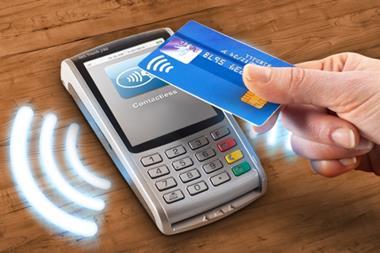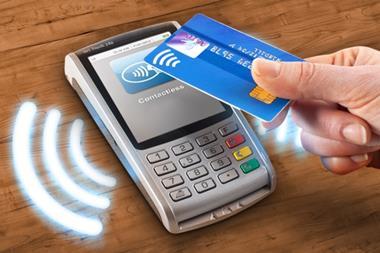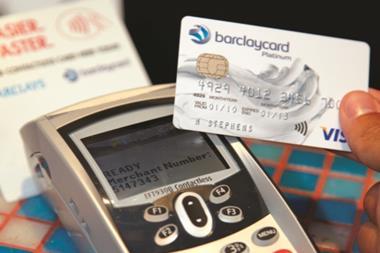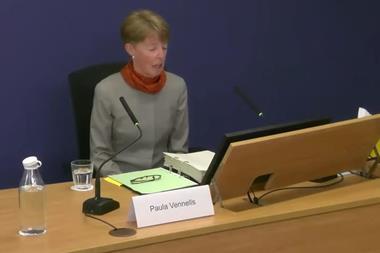Cash remains the most popular way of paying in c-stores, but with alternative options taking off retailers need to move with the times
Cash remains the most popular payment method in the convenience sector, with 81% of customers paying by the paper currency, according to HIM Research & Consulting’s CTP 2014 report. But the use of alternative payment methods to cash and card has grown globally at about 35% on average over the past few years, and is expected to surpass card payments in 2017, according to retail services provider eCommera. The firm claims there are currently over 300 alternative payment options available worldwide, and while the bulk of these aren’t available in the convenience sector, it is proof that consumers are open to different payment options.
With this in mind, a number of retailers have been experimenting with contactless payment solutions. Contactless payment first arrived in 2007 but took until 2014 to really make waves with consumers.
“The total amount spent via contactless in 2014 was more than double all the previous six years combined,” says Richard Koch, head of policy at the UK Cards Association. “People increasingly expect to be able to pay with contactless, and with 69 million contactless cards in circulation there are lots of customers with the technology now in their wallets.”
And more and more convenience retailers are getting in on the action. The Association of Convenience Stores’ (ACS) 2015 Local Shop Report found that 33% of convenience store retailers offered contactless payment, up from 17% last year.
In fact, contactless is so popular that last September the spending limit of contactless payment transactions rose from £20 to £30 (although the ACS warns that the increase is not automatic, so you’ll need to contact your point of sale device provider to update your terminal’s software).
Koch adds: “Accepting contactless payments means faster transactions and the cutting down of queues at the till, leading to fewer abandoned transactions. At the same time it can cut costs for convenience stores as it can reduce the cost and time taken in handling and banking cash.”
Cash is still the most common way to pay in Dan Cocks’ Whitstone Stores in Holsworthy, Devon, but contactless is fast catching up. “Retailers will never turn business away with too much technology - only by having too little,” he says.
Mace retailer Leon Graves of Overpool Service Station, Merseyside, also offers contactless payment, though he claims that he is facing some reluctance from customers. He says: “Contactless is taking a while to catch on because people are worried about losing their card and having it misused by someone.”
However, he notes that it often takes consumers time to adapt to new technology. “People were worried when Chip and PIN first came out, but now it’s my most common payment method. Retailers just need to give contactless some time and embrace the new technology because soon it will be the norm,” he argues.
His view echoes research by Worldpay, which reveals that 46% of all contactless transactions take place in supermarkets and other food retailers.
In addition to making contactless payments using the chip in their cards, some consumers are opting to pay via their mobile phones. Apple Pay allows iPhone 6, 6 Plus and Apple Watch owners to pay for items costing up to £20 by a single touch of their gadget to a payment terminal. Dan has had Apple Pay in his store since it was first launched into the UK in July. “The terminal has been used more than I expected considering it is a new technology,” he says. “On average I get about two transactions a day.”
Leon accepts Apple Pay in-store and is also a big fan of using the technology as a consumer. “I love it,” he says. “Not only does it mean I always have money on me if I forget my wallet, I also don’t have to juggle both when I do. I can just complete the entire process while still keeping hold of my phone.”
He is now working hard to bring his customers round to the idea, too, and slowly they are beginning to take advantage of the new technology.
In Brian and Barbara Humphrey’s Spar store in Wiveliscombe, Somerset, their new Apple Pay terminal has only seen six transactions in the past two months, which they think is down to people’s lack of knowledge regarding the technology. Says Brian: “We have had a lot of interest in Apple Pay, but unfortunately people still have their reservations. I have the application on my phone and have spent a lot of time showing customers how it works. Hopefully as time goes on, and as people understand the technology better, it will be embraced by more as it really is the ultimate convenience.
“People are worried about the security of Apple Pay, but really they just don’t understand it,” he adds. Not only does Apply Pay request a thumb print to log in, it also ensures the card details stored on the phone are never passed to the retailer using a security measure known as tokenisation, whereby the payee receives a single-use ‘token’ allowing them to debit the payment only once.
“Apple Pay is the latest trend,” adds Mehmet Guzel of Simply Fresh, Bethnal Green, “and people tend to follow trends, it just seems to be taking some time.” Although Mehmet himself doesn’t believe there to be any security issues, he agrees with Brian that people think otherwise because of their lack of knowledge, resulting in fewer retailers and customers using it. He would like to see Apple and the banks doing more to make people aware of what is available to them and the security measures in place.
Whether we are ready for it or not, the future of payments appears to be going in the direction of contactless, be it by card or smartphone. “Our children are already more tech savvy with their mobile phones than we are and the ease of carrying just one device rather than a wallet and phone may well win out for them in the end,” says James Frost, UK chief marketing officer at Worldpay. “Contactless is already both convenient and secure, which ultimately means there are few barriers to adoption. The rise in the contactless limit coupled with new near field communications mobile device payment players entering the market should herald a brand new era for contactless.”
For Brian, embracing contactless payment is a no-brainer. He claims that too much cash can be troublesome to count as well as being a security risk in store, while banking it incurs costs. But it is all about striking a balance and, for now, cash is still a crucial payment method. “If people didn’t pay in cash, then we wouldn’t be able to satisfy those customers who want cash back, so it’s a two-way street,” he says. “Luckily, we take about half our transactions by cash, so at the moment there is a good compromise.”
However, he is convinced that contactless payments, especially those made by smartphone, will have a much bigger role to play in the future. “The younger generation have become so hooked on their phones that they daren’t leave the house without them. Retailers need to grasp the technology and go with it - if they don’t they will move backwards, not forwards.”
Cash advanced
The lowdown on next generation polymer notes
Contactless payments may be the next big thing, but cash continues to be the number one payment method with as much as £60bn of coins and notes circulating in the UK today, according to Cashmaster International.
The popularity of cash has led to banks investing in polymer notes. Polymer is a thin, plastic film which enables enhanced security features to be included in banknotes. The notes are already in circulation in Scotland, and the Bank of England is also phasing in the new notes, initially with £5 notes in 2016, followed by £10 notes in 2017.
The new notes are not only more durable and stay cleaner, they also make counterfeiting more difficult. “From a retailer’s perspective they should be more confident in dealing with polymer cash whilst the novelty of the look and feel of the new notes could encourage more consumer use,” says Gordon McKie, Cashmaster International chief executive.
However, it is worth bearing in mind that the notes will not be compatible with current counting systems. Gordon says: “Polymer notes weigh slightly less than paper so, for those who have cash counting systems, existing machines won’t be able to count both.”
The firm is urging its existing customers to upgrade to its Be Polymer Ready upgrade pack, which has the dual functionality of counting paper and polymer notes. The devices fit next to the till and can be integrated with a printer and fully connected to epos or back office systems.
Wholesale change
Bestway adopts Apple Pay technology
It is not just retailers getting in on the act: Bestway Wholesale recently started using Apple Pay in its Abbey Road, London, depot, thus enabling customers to pay for goods using their iPhone or Apple Watch in the depot.
What’s more, unlike other Apple Pay systems operating in the UK, Bestway’s terminal has no ceiling on how much a customer can spend, giving them complete control over their purchasing.
Dawood Pervez, marketing director at Bestway Wholesale, believes that the new payment method will prove successful with its retailer customers.
He adds: “Bestway customers have a much higher usage rate of Apple products than consumers in general. When we launched the Bestway mobile app we did so knowing that 85% of customers have Apple rather than Android devices. The launch of Apple Pay in depot is a natural progression to add convenience to our customers’ business lives and further establish Bestway as their wholesaler of choice.”

























3 Readers' comments